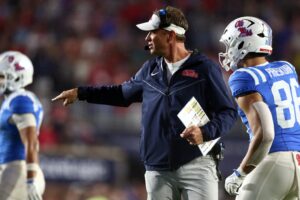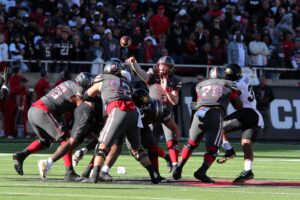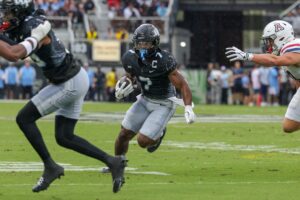Two weeks ago, the NCAA approved several rule changes for the upcoming season. Nothing drives fans crazier than vague rules applied unevenly across the conferences.
College Football Rule Changes We’d Like To See
Among the rules approved by the NCAA two weeks ago were:
- Touchback awarded for a fair catch inside the 25-yard line on a kickoff.
- Prohibition of blocking below the waist more than five yards from the line of scrimmage
- Utilizing a play clock after touchdowns and kickoffs
But why stop there? There are plenty more rules that need to be addressed with college football. From the serious to the sublime, here’s a look at some college football rule changes that will make the game we love just a little better.
Clarifying the Catch Rule
The three great questions of life are “Why are we here?”, “What is my purpose?”, and “What constitutes a catch?”. File this under the ‘easy things we make hard’ category. The catch is complete once the receiver has possession. That’s it. Whether he’s out-of-bounds or down-by-contact is simply a corollary question.
Granted, it’s hard to apply definitive measurements to the ruling. A receiver could easily established possession without taking a set number of steps. Footballs can move in receivers’ hands even after possession is demonstrated. This is one of those rules that is more about the officials understanding the intent of the rule rather than the particulars.
Too often, officials default to incomplete. They ask too many questions and end up convoluting the entire process. Possession should be assumed and for a ruling to be incomplete, the officials should be able to clearly see that the receiving player never established possession.
Targeting
Safety is of paramount concern in game of football today. And well it should be. Football faces an existential crisis from the concussion and CTE threats that players–professional and amatuer–face while playing the game.
The targeting rule was put in place to address excessive and unsafe hits, particularly against defenseless players. And while the targeting rule serves an important role in the regulation of the game today, it needs improvement in two key areas.
First, it must be applied consistently across college football. This is absolutely imperative and something officials must get right. Not only do those assessed a targeting foul get ejected from the game, but they could miss half of the next game if the foul occurs in the second half.
Secondly, defensive players ought to be protected from the movement of offensive players. That means intent should be considered. If an offensive player changes position after the defensive player is already in the tackling motion, it’s entirely unfair to the defensive player to be penalized for a hit, assuming there was no launching or other factors that contributed to the targeting hit.
Defensive players, particularly in the secondary, are already hamstrung by rules like pass interference. The rules should protect them in some instances.
Staff Sizes
Let’s talk about some things off the field. Some schools are weaponizing their staffs. Analysts for this, analysts for that. It’s like a rehabilitation program for ousted former coaches. While the NCAA limits the size of the of the on-the-field coaching staffs, there is no limit to the overall size of the staff.
This one is simple. The NCAA should have a set number for non-students on a staff. One number for on-the-field coaches, one number for graduate assistants, and one number for all other non-student staff members.
Tired the rotating door of coaches and want to go one further? How about instituting a rule that an NCAA coach cannot hold a position more than one level away from a previous position and cannot get paid less than the average among the rest of the FBS schools for that position level. That will ensure schools don’t bring on five ex-head coaches as “analysts” and have a football think-tank in the film room.
Recruiting
Yes, you could write a Masters Thesis on necessary regulation of the recruiting machine. But here’s three starting points.
First, limit the overall number of times a school can contact–in any manner–a student athlete. One ten minute phone call a week. One piece of mail a week. Two school/practice visits overall. One in home visit during their senior year of high school. That’s it. We live in the age of Hudl and Twitter. Leave the kids alone. Watch the film, watch the twitter feed. Talk to them once a week. That’s all you need.
Second, implement more quiet periods and lessen the recruit contact periods. Four weeks in the summer. Any time when the recruits school in session. That’s it. Make the coaches and the schools prioritize which coaches they send where. Make them prioritize the student-athletes they want.
Lastly, get rid of the National Letter of Intent system. It’s completely skewed in the schools’ favor. Go to a system similar to a regular college admission system. Schools are only allowed to make scholarship offers from a set date, say, the first Wednesday in February (see what I did there), and student athletes have until the last Wednesday in March to sign those offers. If a school extends an offer and a student athlete signs that offer, the school must honor it. This will also make the student athletes make hard decisions, which is part of the learning experience of college.
The Devil is in the Details
Certainly, there’s more details to work out in any change of the above rules. But they are all doable. And they would all make the game better. It’s time to take a hard look at some of these college football rule changes.
What is the old fan refrain? Maybe next year.
Main Photo:
Embed from Getty Images






